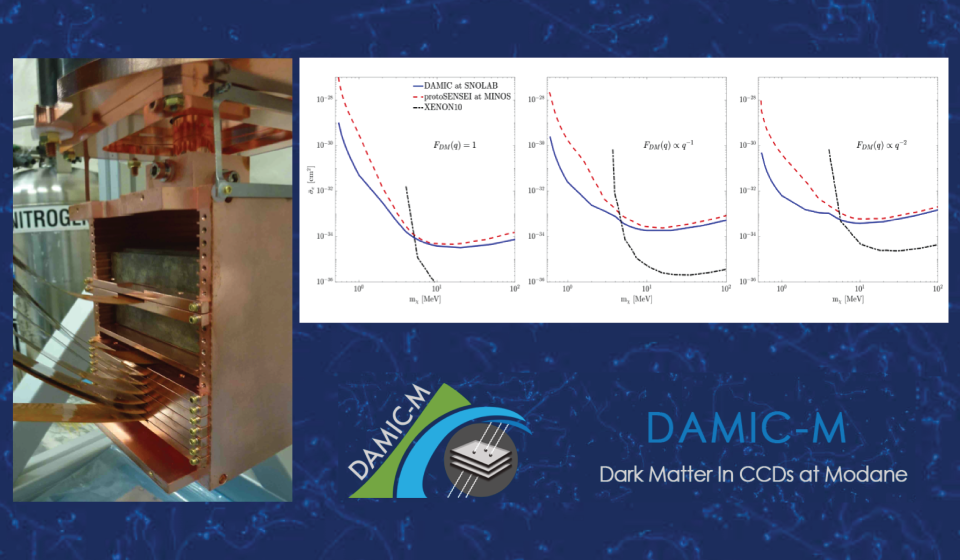
The DAMIC Collaboration presented their latest
results on the search for light dark matter particles (MeV-scale masses) for
the first time in the International
Conference of Cosmic Rays 2019. The results
were posted on arXiv [https://arxiv.org/abs/1907.12628] and will be published
soon.
DAMIC (DArk Matter In CCDs) is an experiment that uses as detection technique scientific CCDs with an unprecedented sensitivity to sub-GeV dark sector DM particles. Under the hypothesis that dark matter (DM) is made of neutral and stable particles, essential to reproduce the correct relic abundance, DAMIC will mainly explore two dark matter candidates which are well-motivated theoretically and observationally: a) low-mass WIMPs (Weakly Interactive Massive Particle) with a wide mass range to explore, and b) the dark sector where the Dark Particles have their own set of interaction forces and thus do not couple directly with (are “hidden” from) baryonic matter.
The DAMIC detector is currently located at
SNOLAB, Sudbury (Canada), 2 Km below the surface in the Vale Creighton Mine
near Sudbury. The detector features 40 g of sensitive mass and very low
background. The DAMIC CCDs produced at
the Lawrence Berkeley Laboratory achieved a record thickness of 675 microns
with an area of 6cm x 6cm, for a mass of 5.8 g with 4000x4000 pixels of size
15x15 mm2.
These CCDs present high spatial resolution and 3D reconstruction, an excellent
energy response, an unprecedentedly low energy threshold of a few tens of eV
and extremely low leakage current. This allows a unique capability to identify
and reject the background as spatially correlated events occurring at different
times. All this makes the DAMIC CCDs a well-suited detector to identify and
suppress radioactive backgrounds, having an unrivalled sensitivity to WIMPs
with masses < 6 GeVc-2.
DAMIC reports on direct-detection constraints
on light dark matter particles interacting with electrons. The results are
based on a method that exploits the extremely low levels of leakage current
(2-6×10−22 A cm−2) and evaluates the charge distribution of pixels
that collect less than 10 e− for contributions beyond the leakage
current that may be attributed to dark matter interactions. The constraints on
DM are placed on a so-far unexplored parameter space for dark matter masses
between 0.6 and 100 MeV c−2 for DM-electron free scattering cross
section. New constraints are also placed on hidden-photon dark matter with
masses in the range 1.2- 30 eVc−2. DAMIC has established the best
direct-detection limits on DM-electron scattering in the mass range of 0.6 MeVc−2
to 6 MeVc−2 by exploiting the excellent charge
resolution and extremely low leakage current of DAMIC CCDs. The
collaboration has also placed the best direct-detection constraints on
hidden-photon dark matter in the mass range 1.2–9 eVc−2.
IFCA belongs to the DAMIC collaboration since May 2017,
and is also part of the next generation of the experiment,
DAMIC-M, that will be located in
Laboratoire Souterrain de Modane (LSM), Modane (France). DAMIC-M will feature a
detector mass of ~1 Kg with unprecedented single-electron resolution and a
large reduction of the backgrounds, and will host the most massive CCDs ever
built. The experiment will consist of 50 CCDs, each having 14g of active mass
and 36 Megapixels (6k x 6k). IFCA is involved in the study of backgrounds,
simulations and a Data Quality Monitoring.
DAMIC-M is already approved and funded by the
US National Science Foundation, and also supported by an ERC grant from the
European Council. The grant was awarded to the spoke person of the experiment,
Paolo Privitera, from University of Chicago and the Laboratoire de Physique
Nucléaire et
Hautes Énergies (LPNHE, CNRS/Sorbonne université/Université Paris Diderot)
and consists of 3.5 M Euros for the next 5 years.
Figure. Left:
DAMIC detector, with the CCDs
Right: The 90 % C.L upper limits on the DM-electron free scattering cross
section (σe) as a function of DM mass (mχ) for three different dark-matter form
factors (FDM) obtained by DAMIC at SNOLAB (solid blue line). Other lines
present results from competing experiments.
